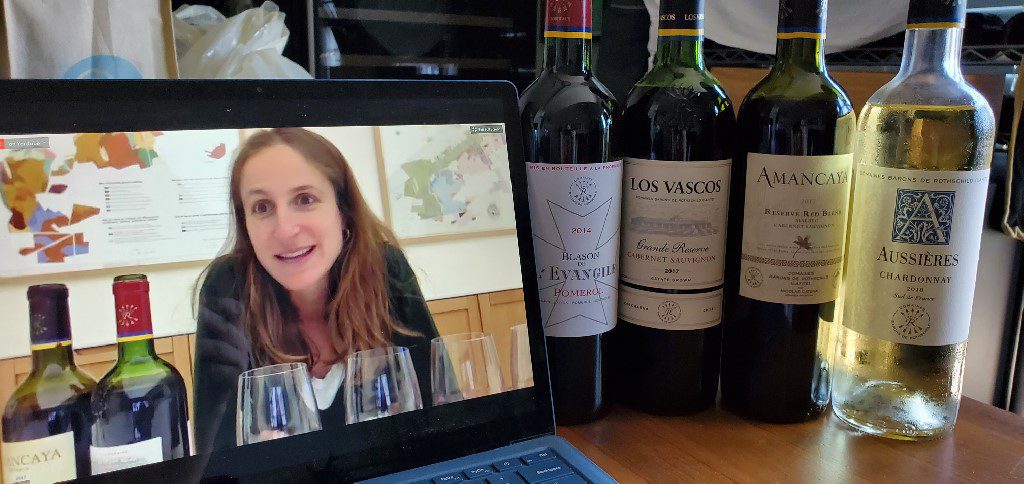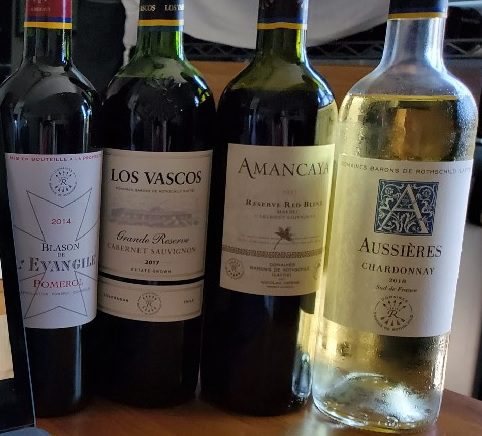
07 Jul Changing the image of Bordeaux
While I cannot travel to wineries to visit wineries and meet winemakers, the benefit to the world we live in is that I can still meet with winemakers via virtual tastings. Of course, I would have loved to have traveled to Bordeaux, but it was still a pleasure to meet Saskia de Rothschild, the youngest person to run a first-growth Bordeaux estate, as well as the first woman to run one. Saskia is focused on changing the image of Bordeaux which I wrote about in the Napa Valley Register and share here.
Bordeaux produces some of the most expensive wines in the world and is one of the most collectible wine regions in the world. Sitting at the very top spot as the most expensive and sought-after Bordeaux is Lafite.
Bordeaux, specifically First Growth Bordeaux, is often seen as a wine for older drinkers and for wine collectors. But despite the prestige, Bordeaux is a region often thought of as pretentious, stuffy and haughty. It is these perceptions that have hurt the Bordeaux image when it comes to younger drinkers.
With the desire to revitalize the Bordeaux image, Saskia de Rothschild, the youngest person to run a first-growth Bordeaux estate, is focused on making Bordeaux more approachable and appeal to younger, and new, generations of wine drinkers. Saskia de Rothschild is the daughter of Baron Eric de Rothschild, who began running Lafite in 1974. While he is still involved with the family company, it is now in the hands of his 33-year-old daughter.
The idea of Saskia taking over the family empire was not a given. However, her fascination for wine began at an early age, and Saskia prepared herself by first interning at Château L’Évangile in Pomerol at the age of 19.
She then joined the group that selects Lafite’s assemblage (the final blends that end up in bottles) at 20 and joined the Domaines Barons de Rothschild Board in 2008.
Saskia has an MBA from HEC Paris and a master’s degree in journalism from Columbia University. She worked for The New York Times in Paris and West Africa and has also written for The Washington Post, Libération, Le Monde and Vanity Fair.
She officially returned to the family company in 2015. Instead of joining the family business with no formal training, she received her national diploma in viticulture and enology form the agricultural school CNEAC in Argenton-sur-Creuse and spent time immersing herself at the estates to really understand what it would mean to take over.
In April 2018, at 31, Saskia not only became the youngest person to currently lead Château Lafite Rothschild, a first-growth Bordeaux estate, but also the first female chairwoman of Domaines Barons de Rothschild (Lafite), her extended family’s global wine empire, which includes seven other wineries on three continents, 430 employees and 1,200 hectares of vineyards worldwide. Saskia is more than the face of the company. As the sixth generation of the winemaking family, Saskia is focused on reinventing and reinvigorating the perception of Bordeaux wines.
As a millennial, Saskia brings a more youthful and forward-thinking perspective to Domaines Barons de Rothschild. She has brought the 150-year-old company to the future through social media. An Instagram account called “thedomaines” offers a behind-the-scenes look at the family’s four Bordeaux wine estates—Château Lafite Rothschild (Premiere Cru Classé in Pauillac), Château Duhart-Milon (Grand Cru Classé in Pauillac), Château Rieussec (Premier Grand Cru Classé in Sauternes) and Château L’Évangile (Pomerol). Now anyone can see the vines, the barrel rooms, the winemaking team and anything else that shows that these esteemed brands are a family affair.
Elevating the brand’s social media presence also included transforming one of the season’s most anticipated events, En Primeur, to a virtual event. Traditionally, En Primeur is the time when Bordeaux estates open their doors to offer a sneak peak of their latest vintage. En Primeur has occurred during wars and other crises. But with the current global pandemic, they shifted it online, offering virtual tastings and switching the conversation to social media. And the benefit to this is that it allowed the wine estates to reach a larger, and potential new, audience to showcase the 2019 vintage.
With an increasing demand from consumers for organic and biodynamic wines, Saskia has been working to convert the group’s estates to sustainable and organic agriculture. She is focusing on each estate, taking a holistic approach to the ecosystem. Château Lafite Rothschild has been experimenting with biodynamic practices and will be 100-percent organically farmed this year. In fact, all of the French estates are converting to organics this year, including Château L’Évangile and Chateau d’Aussières.
Château L’Évangile in Pomerol (on the Right Bank) is a small estate that was acquired by Domaines Barons de Rothschild in 1990, is in its third vintage of organic farming. The estate was converted to organic farming and in the first year, there was frost. The second year there was mildew due to humidity. Learning from their mistakes, Saskia explained that the third year (2019) was a good vintage.
I tasted the Château L’Évangile Blason de L’Evangile 2014 ($74.99), a wine that is predominantly Merlot (92 percent) with eight percent Cabernet Franc blended in. A deep color, the wine has a fresh, fruity nose of cherry, black currants and raspberry, with a touch of chocolate. On the palate, the wine is velvety with silky tannins that coat the tongue yet is balanced by acidity for a long finish. This is a wine to enjoy with a grilled steak.
Chateau d’Aussières is located in the Languedoc region in the south of France. Domaines Barons de Rothschild acquired the property 20 years ago. They restored it, and since then it has seen a surge in popularity of the region with the quality of wines improving immensely.
The Chateau d’Aussières Chardonnay 2017 ($12.99) is a bright yellow color with light green highlights. An aromatic wine, there are floral and citrus notes. The wine spends a little time in wood and is aged on the lees, giving the wine richness and body but the wine is also fresh and vivacious with a saline finish. This wine can be enjoyed with oysters or fried chicken.
In addition to the five properties in France that are converting to organics, Domaines Barons de Rothschild has expanded outside of France with three properties.
Baron Eric de Rothschild found the Los Vascos estate in Colchagua, Chile in 1988. When he first visited Chile, there were no other French people in Colchagua. There were only 100 hectares planted at the time and he fell in love with the area. The Los Vascos Grande Reserve Cabernet Sauvignon 2016 ($17.99) is a ruby red color with notes of ripe red fruits such as cherry and plum, as well as notes of chocolate, black olive, cedar and an herbaceous finish.
In 1999, Domaines Barons de Rothschild partnered with the Catenas in Argentina. They had always been curious about Malbec, which used to be planted in Bordeaux, and found a like-minded partnership with the Catena family. They blended Cabernet Sauvignon (33 percent) with Malbec (77 percent). The CARO Amancava 2017 ($18.99) is a deep ruby color with aromas of bright red and purple fruits, such as red cherries, blackberries and fig paste, as well as hints of spice. A balanced wine, it is approachable yet affordable and is easy to pair with pizza and pasta.
In 2008, Domaines Barons de Rothschild started working in China at Long Dai and launched the wine in 2019.
The Domaines Barons de Rothschild look for value when seeking out a new property. And Saskia is looking to add more wineries to the portfolio, including a possible winery in Ethiopia.
With an open mind and a clear focus, Saskia de Rothschild is focused on changing the image of Bordeaux by making it sustainable and cool.
Read the original story in the Napa Valley Register.
Discover more from Please The Palate
Subscribe to get the latest posts sent to your email.




